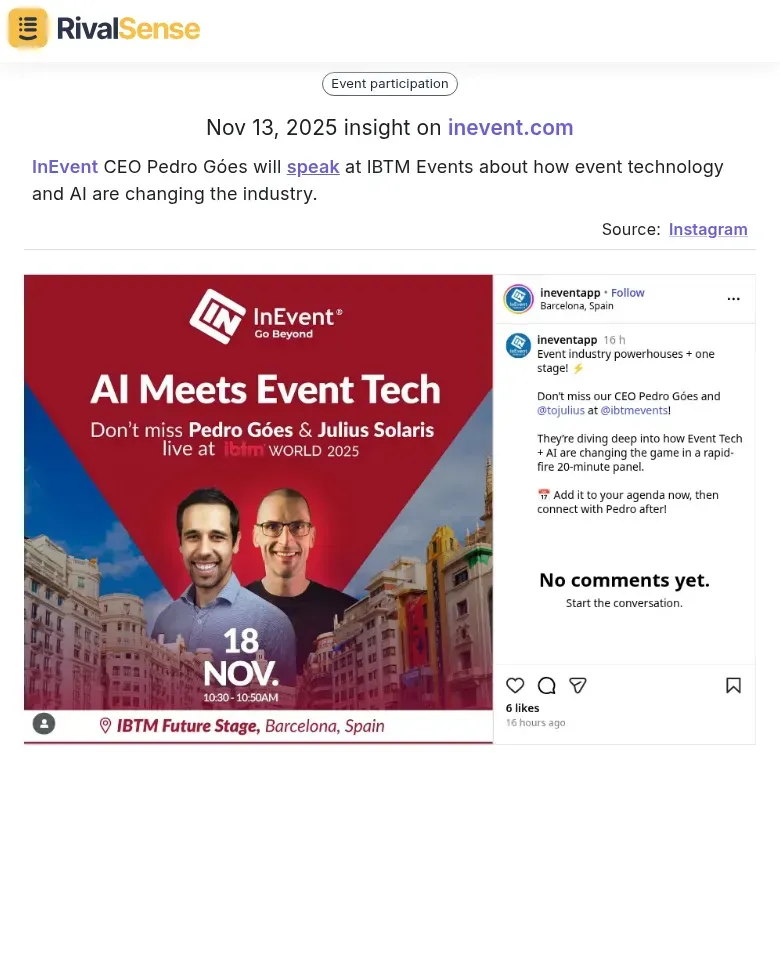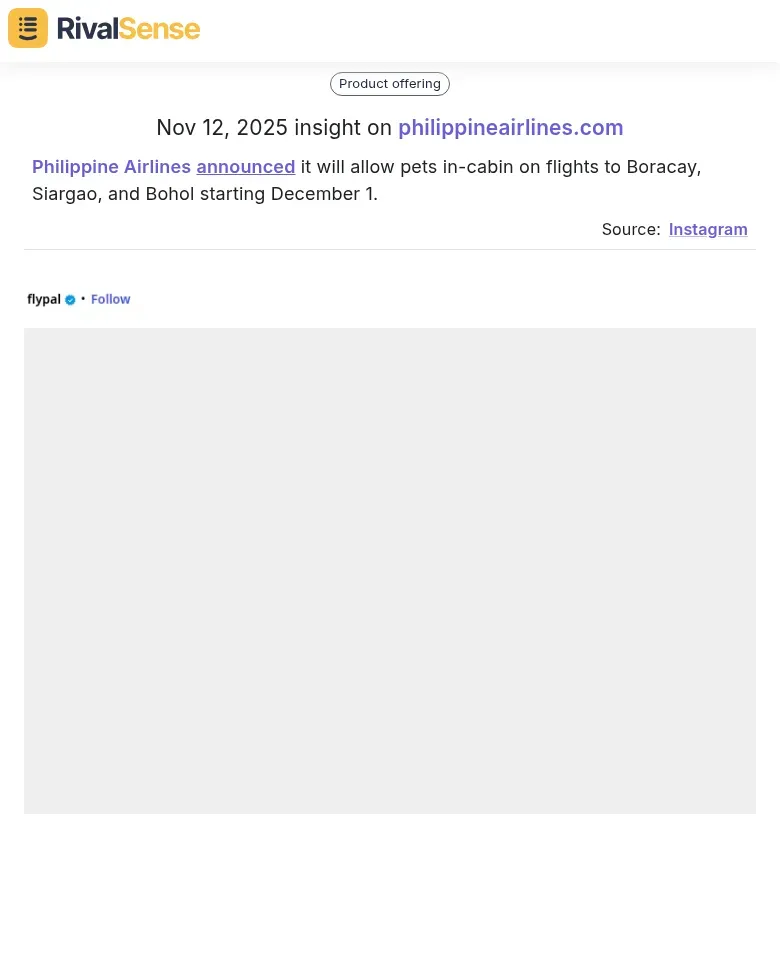Instagram Competitor SWOT Analysis: Uncover Strategic Insights
Understanding your competitors on Instagram is essential for maintaining a competitive edge in today's digital marketplace. A SWOT analysis—assessing Strengths, Weaknesses, Opportunities, and Threats—provides a structured framework to dissect rival strategies and uncover actionable insights. By systematically evaluating competitors' content, engagement, audience growth, and advertising approaches, you gain a clear picture of what works and where gaps exist. This isn't just about mimicking tactics; it's about identifying opportunities to differentiate and strengthen your own Instagram presence. For example, if a competitor excels in user-generated content but neglects video reels, that's a chance to capitalize on an untapped format. Real-time competitor monitoring is crucial here—tools like RivalSense track changes instantly, allowing agile strategy pivots. When you spot a rival launching a successful campaign or facing backlash, you can adapt quickly, whether by emulating wins or avoiding missteps.
Consider how tracking events can inform your strategy: RivalSense insights, such as Vietjet Air hosting the Vietjet Melbourne@Vibing event on December 13, 2025, showcase the value of monitoring competitor activities. This type of insight is valuable because it reveals how competitors engage audiences through real-world events, which you can leverage in your Instagram content to boost relevance and engagement.

Practical steps to get started:
- Identify 3-5 key competitors on Instagram
- Use a tracking tool to monitor their posts, hashtags, and engagement metrics daily
- Analyze their SWOT quarterly, noting trends like rising follower counts or declining comments
- Integrate insights into your content calendar—e.g., if competitors' educational posts drive shares, prioritize similar value-driven content
This proactive approach turns competitor data into actionable decisions, boosting your competitive edge without guesswork.
Strengths: Learning from Competitor Successes
Analyzing competitor strengths on Instagram helps you learn from their winning strategies and apply them to your own efforts. By identifying what drives their high engagement and growth, you can refine your content and campaigns for better results. Focus on three key areas to extract actionable insights from their successes.
First, identify high-engagement content formats by tracking which posts generate the most comments, shares, and saves. Look for patterns in successful Reels, carousels, or user-generated content campaigns. For example, if a competitor's behind-the-scenes Reels consistently outperform polished product shots, adapt your content mix accordingly.
Second, examine posting frequency and timing. Use Instagram Insights or competitor tracking tools to determine optimal posting windows when their audience is most active. Create a weekly schedule that aligns with these peak engagement periods while maintaining consistent quality over quantity.
Third, study successful influencer partnerships and event-driven campaigns. Note which collaborations drive authentic engagement versus mere product placement. Track how competitors leverage holidays, industry events, or user-generated content challenges to boost visibility.
✅ Practical Checklist:
- Document top 3 performing content formats from 2-3 key competitors
- Map posting schedules against engagement metrics for 2 weeks
- List 5 most effective influencer collaborations with engagement rates
- Identify 3 seasonal/event campaigns that drove measurable results
- Test one new strategy from your findings each month
Weaknesses: Identifying Competitor Gaps and Vulnerabilities
Identifying weaknesses in your competitors' Instagram presence reveals strategic gaps you can exploit to gain an advantage. By spotting where they underperform or neglect opportunities, you can tailor your strategy to fill those voids and attract their audience. Start by analyzing underperforming content types—track posts with consistently low engagement rates, high unfollow rates, or negative comments.
For example, if a rival's video tutorials receive minimal shares, pivot to text-based guides. Assess audience interaction gaps: monitor response times to comments, frequency of community Q&As, and participation in trending conversations. If competitors ignore new features like Instagram Reels or shopping tags, capitalize on these missed opportunities. Evaluate their blind spots in emerging trends—are they slow to adopt AI-driven content or niche hashtags? Use tools like RivalSense to automate tracking of engagement metrics and trend adoption.
🔍 Practical Steps:
- Create a weekly audit checklist comparing your content performance against competitors'
- Set up alerts for competitor campaign launches to gauge audience reception
- Identify untapped market segments they overlook, such as micro-influencers or local communities
By focusing on these vulnerabilities, you can refine your strategy to fill gaps and avoid their pitfalls.
Opportunities: Capitalizing on Market Trends and Innovations
Opportunities in competitor analysis arise from market trends and innovations that rivals adopt or overlook. By monitoring their moves, you can identify new avenues for growth and engagement on Instagram. When competitors announce events or partnerships, analyze them for untapped niches and emerging trends.
For instance, RivalSense tracked that InEvent CEO Pedro Góes will speak at IBTM Events about how event technology and AI are changing the industry. This insight is valuable because it highlights how competitors are positioning themselves in evolving sectors, allowing you to anticipate industry shifts and align your Instagram content with relevant discussions on technology and innovation.

Create a checklist to capitalize on opportunities: identify announcement gaps, assess audience overlap, and test small-scale initiatives. Adopt successful AI integrations from leaders, like using AI for personalized content recommendations or automated engagement analysis. Steps include monitoring competitor tech updates via tools like RivalSense, piloting similar features, and gathering user feedback.
📈 Tips for Action:
- Conduct A/B testing on enhancements inspired by competitor activity
- Prioritize customer experience improvements based on competitor feedback loops
- Iterate quickly to capitalize on emerging trends and innovations
Threats: Mitigating Risks from Competitor Moves
Threats from competitors can emerge unexpectedly and disrupt your market position if not addressed proactively. By monitoring their activities, you can mitigate risks before they escalate and protect your Instagram strategy. Track competitor expansions into new markets or audience segments that could dilute your share.
For example, if a rival launches in a city where you're dominant, assess whether their entry threatens your customer base or pricing power. Policy changes by competitors also reshape customer expectations; consider how Philippine Airlines announced it will allow pets in-cabin on flights to Boracay, Siargao, and Bohol starting December 1. Tracking such policy changes with RivalSense is valuable because it helps you see shifts in industry standards that could threaten your service differentiators if not adopted promptly.

Use tools like RivalSense to set alerts for competitor announcements, funding rounds, or geographic moves. Regularly review competitor terms, pricing models, and feature updates to anticipate shifts in market standards.
🛡️ Checklist for Risk Mitigation:
- Perform monthly policy audits of competitor activities
- Analyze customer feedback to identify emerging threats
- Maintain a crisis playbook with messaging templates for industry-wide reputation risks
- A/B test responses to competitor-led trends to stay agile
Implementing Strategic Insights from SWOT Analysis
Transforming your Instagram competitor SWOT analysis into actionable strategies requires a continuous and systematic approach. By implementing insights regularly, you can maintain a competitive edge and adapt to changing market dynamics. Start by aligning each part of the SWOT with specific actions: for competitor strengths, find ways to differentiate; for weaknesses, exploit gaps; for opportunities, innovate; and for threats, prepare countermeasures.
Create a continuous monitoring plan using tools like RivalSense to track competitor posts, hashtag performance, and audience growth weekly. Set up alerts for major changes, such as new campaign launches or shifts in content strategy. Integrate findings into your business strategy by updating marketing goals based on SWOT insights—for example, if competitors lack video content, prioritize Reels in your roadmap.
📋 Implementation Checklist:
- Review competitor profiles and engagement metrics monthly
- Update SWOT matrices quarterly to reflect new trends
- Adjust tactics based on real-time data from tracking tools
- Test and scale successful strategies from your analysis
To streamline this process and gain deeper insights, try RivalSense for free at https://rivalsense.co/ and get your first competitor report today to start turning competitor intelligence into a sustainable advantage.
📚 Read more
👉 Advanced Tactics: Uncover Your Competitors' Aviation Edge
👉 Mastering Market Entry with Competitor Win-Loss Analysis
👉 Real-World Competitor Analysis: Tracking Leadership Changes
👉 The Ultimate Guide to Setting Up Key Account Tracking: A Practical Playbook for B2B Leaders
